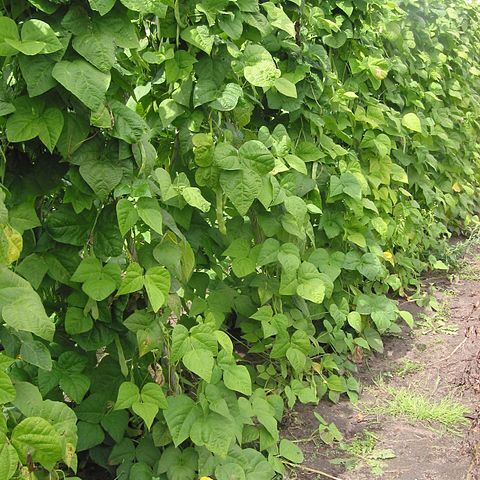Vines, herbs or subshrubs. Leaves pinnate trifoliolate, the leaflets mostly entire, pubescent or glabrate but minute, uncinate hairs present, the stipels often oblong, thin, glabrous; stipules acute, nervate, often pubescent, not prolonged below the insertion. Inflorescences axillary, the flowers congested in fascicles along the rachis, the nodes not swollen, not glandular, the rachis eglandular; bracteoles ovate or greatly reduced and much shorter than the calyx, nervate, puberulent, persistent at least until anthesis; bracts ovate or lanceolate, nervate, puberulent; pedicels mostly longer than the calyx. Flowers blue, purple, violet, yellow or white; calyx mostly 2-lipped, the upper teeth partly united; standard symmetrical, orbicular, basally appendaged, the wings partly spiralled, apically cucullate, the keel in 2-3 spirals; vexillary stamen free, the free part of the others elongate, the anthers nearly uniform; ovary 1-many ovulate, the style apically thickened, curved in 1.5-2.5 spirals, hairy inside, distally caducous. Legume linear or oblong, straight or slightly curved, not septate, compressed or turgid, sometimes beaked; seeds 1-many, oblong to reniform, the hilum short and cen-tral.
Twining or erect herbs, often with hooked hairs. Stipules basifixed, persistent, not produced below point of insertion. Leaves pinnately 3-foliolate; stipels present. Racemes axillary, flowers at swollen nodes. Bracts and bracteoles persistent or deciduous. Calyx 2-lipped, upper pair of teeth connate, lower lip 3-toothed. Corolla yellow, white, red, or purple; petals clawed; standard suborbicular, reflexed, sometimes with appendages at base; wings obovate or oblong, adherent to keel; keel linear, beak long, spirally coiled through 1-5 turns. Stamens diadelphous. Style spirally coiled through at least 360°; stigma oblique. Legumes linear or oblong, subterete or compressed. Seeds 2 to many, oblong or reniform; hilum shortly linear, estrophiolate.
Cal-tube hemispheric, slightly oblique; lobes 5, subequal, shorter than the tube; standard rotund, its sides folded over the other pet; wings semi-obovate, coherent with the keel; keel-pet linear-oblong, at the summit incurved and spirally coiled; stamens 10, diadelphous; style bearded along the upper side, spirally coiled and thickened beyond the middle; fr terete or flattened, with few–several seeds; twining or erect herbaceous perennials with pinnately trifoliolate lvs, small few-nerved stipules and bracts, and small to medium-sized fls each closely subtended by a pair of minute bracteoles. 200+, mainly warm New World.
Climbing annuals or perennials, usually herbaceous; stems rounded. Lvs pinnately 3-foliolate or rarely with 1 leaflet, stipellate; petiolules unequal; stipules simple, striate. Infl. axillary, racemose, few-to many-flowered. Calyx campanulate; calyx teeth much < tube, connate or free. Keel spirally twisted; stamens diadelphous; anthers uniform. Style thickened within the beak of the keel and twisted with it; ovules numerous. Pod terete or compressed, 2-valved; seeds with a small hilum, estrophiolate.
Standard rounded, auriculate, often considerably reflexed, with 2 appendages or with only slight appendages at the side of the claw and a transverse constriction above or with none; wings often following the spiral of the keel, often broadened and cucullate at the apex; keel often narrow, elongated, the apex beaked and forming a spiral of 1–5 complete turns.
Ovary oblong to linear, 2–many-ovuled; style tenuous below, filiform and flexible, the apical part cartilaginous and thickened, curved through at least 360°, glabrous or hairy inside towards the summit; stigma oblique on the inner side of the style apex or sometimes smaller and terminal or subterminal, not penicillate.
Inflorescences axillary, falsely racemose, the flowers in fascicles along the rhachis which is swollen at the insertion of the pedicels; bracts and bracteoles present, deciduous or ± persistent.
Leaves pinnately 3-foliolate, rarely 1-foliolate; stipules persistent, not prolonged below the point of insertion, striate; stipels present.
Vexillary stamen free; free part of other filaments usually long; anthers subuniform or 5 dorsifixed alternating with 5 basifixed.
Seeds 3–many, oblong or reniform; hilum oblong, short, ± central, without appendages or with them somewhat developed.
Pods linear or oblong, sometimes falcate, compressed or subcylindrical, sometimes beaked, filled between the seeds.
Calyx 5-lobed, 2-lipped; upper lip emarginate, bifid; lower lip 3-lobed.
Flowers usually fairly small, yellow, white, scarlet or purple.
Herbs or subshrubs, erect, prostrate or climbing.

